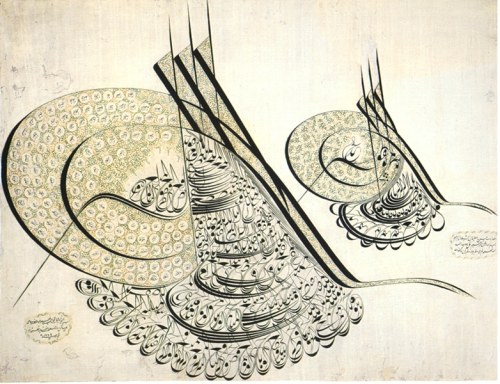

Two tughras, Turkey, 1845
Source: http://www.islamicart.com/main/calligraphy/catalog/index.htm
(downloaded April 2000)
"Ottoman Turkey, Istanbul, 1845 AD. Ink, gouache and gold on paper. 21 1/4 x 28 in. Riyadh, Rifaat Sheikh El-Ard collection. Sotheby's (1985), lot 250.
These compositions are both derived from the imperial Tughra - official monogram of the Ottoman sultan. In the 19th century, religious invocations were occasionally written in this form. N° 46 has two tughra. The large one contains the Asma' al-Husna, the Divine Names of Allah, and parts of Surah CXII,AI-Ikhlas, Purity. The smaller one,like the little cartouche next to it, invokes Allah's protection against Satan. N 47 consists of four separate invocations in the form of Tughra, together with one in mirror-script invoking the name of Jalal al-Din Rumi, the famous 13th century mystical poet and founder of the Mevlevi Order of Dervishes, the best known of all the Sufi orders.
The calligrapher gives his name as Sayyid Umar al-Wasif, of Sivas in eastern Anatolia. These pieces were executed in 1845 when he was living in Istanbul. At least four compositions by him are known, all employing the same complex, distorted Thuluth script in which the same letter shapes are repeated almost ecstatically - time and again. The compositions were presumably intended for display in one of the Mevlevi foundations inhabited by dervishes, such as that of Galata in Istanbul."